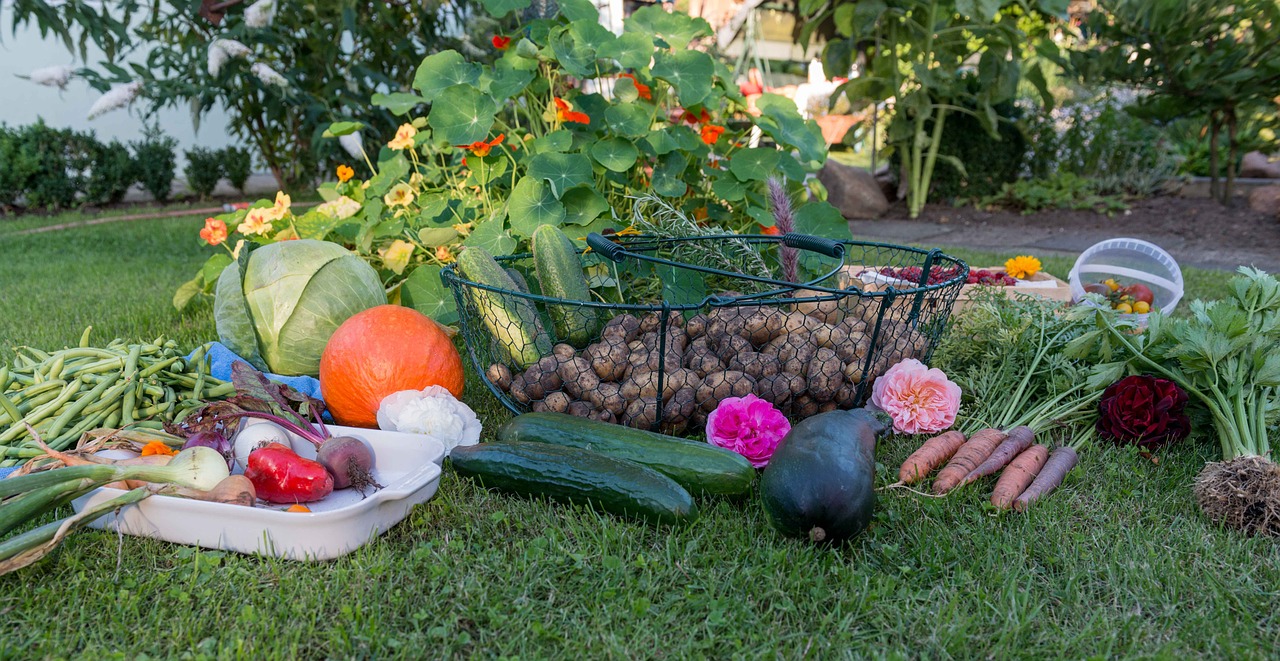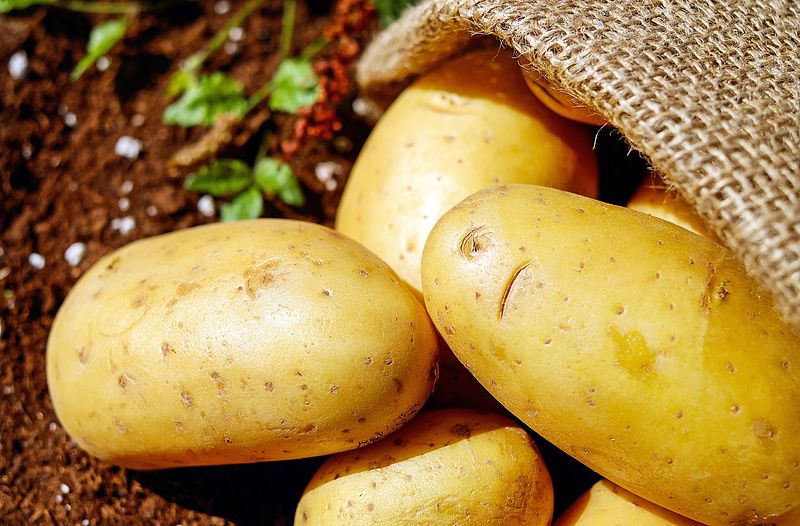Gardening doesn’t come naturally to everyone and maybe downright intimidating to some. But the ability to feed yourself and your family when SHTF is paramount, so find your inner green thumb and start digging.
Please keep it simple and focus on fruits and vegetables that are easy to grow, cook, or eat raw without sacrificing the essential nutrients.
Leafy Vegetables
Dark leafy green vegetables are among the easiest to grow and the most nutritious. They’re chock full of vitamins and antioxidants, plus fiber, iron, and calcium, and you can grow as many of these plants as possible to feed your family the recommended two cups each day.
- Collard Greens: Preferring cooler weather, collards are a variety of cabbage that grows best in rich, well-drained soil and full sun. The leaves can be bitter if eaten raw, so you’ll probably want to cook them. Eating this healthy plant helps lower our risk of cancer.
- Kale: If you’re looking for a cold-hardy green with a unique taste, give kale a try. Cooler temperatures take away some of its bitterness and give it a sweeter taste. Kale grows quickly and needs a lot of sunshine and up to 1 ½ inches of water each week.
- Swiss Chard: This green member of the beet family does well in cool and warm weather and grows in full sun and light shade. Swiss chard is biennial, having a two-year life cycle, and grows quickly. It’s resilient and is not usually bothered by insects or diseases. Once harvested, Swiss chard can be frozen for up to a year.
Beans & Legumes
You may not have access to meat when disaster strikes, but you’ll still need protein. That’s where beans and legumes come in. These unique plants add nutrients to the soil (in the form of nitrogen) and add high-quality protein to your diet.
- Green Beans: This veggie is often a favorite of kids due to its mild taste. There are two varieties to pick from, depending on your garden space. The bush bean grows lower to the ground and doesn’t need support, but beware: They’re a favorite of mice, so you may need to cage them. Pole beans grow on a vine and require a trellis or other support.
- Broad Beans: You don’t need a nice chianti to enjoy broad beans from your garden (also known as fava beans). They grow best in full sun and rich, fertile soil. This cool-weather annual should be planted away from strong winds, so stems don’t snap once they’re laden with bean pods. Broad beans are highly nutritious and can help with your body’s immunity.
- Peas: Peas are a legume and among the easiest plants to grow. Once in the ground, all you need to do is water and harvest. Pests and diseases typically stay away. Peas do best in cooler temperatures, and younger plants will even tolerate a light frost, but they need full sun and well-drained soil. Peas have a sweet taste and provide just about every vitamin and mineral you need.
Starchy Vegetables
While you’re getting your vitamins and other nutrients in leafy greens and legumes, your body also needs plants rich in calories and carbohydrates to survive. That’s where starchy vegetables come in.
- Potatoes: If you can’t grow potatoes, you may as well give up! They are one of the easiest vegetables to grow. Potatoes do best in excellent, well-drained soil and can be planted very early in the gardening season. They also need about six hours of full sunlight per day. Dig a trench about eight inches deep and use seed potatoes as your starters. These are the spuds with protruding eyes. The most challenging part about potatoes isn’t growing them but storing them so they don’t rot or pre-maturely sprout. They need to be kept in a cool, dry place such as a cardboard box or potato bin. Give them plenty of air, and do NOT store them with your onions unless you want them to start sprouting.
- Sweet Potatoes: Sweet potatoes are high-calorie crops; something to look for when planting your survival garden. They provide vitamin A, potassium, and fiber, as well as carbohydrates for energy. Depending on the variety, one plant can provide 4-8 tubers per growing season. ‘The young shoots and leaves of sweet potatoes can be eaten as greens.
- Squash (Acorn and Butternut): There are many squash varieties, but acorn and butternut are easy to grow and very nutritious. These winter squashes are ready to harvest when the rind is hard and thick. They are simple to store without refrigeration or canning, making them a no-brainer for a survival garden. Each vine can yield up to 20 squash, but they need a lot of space to flourish. Each hill should have at least 50 square feet.
Fruits
Gardening to supply food for your family doesn’t mean it has to be all veggies and no fun. Several fruits fit right into your garden without a lot of effort and provide some much-needed sweetness to your diet.
- Strawberries: Sweet and juicy when ripe, strawberries are a family favorite and a gardener’s dream. These plants spread so well, and you’ll need to control them by pruning the majority of the plants so they establish a healthy root system and make sure taller plants are not overshadowing them. Strawberries need full sun and well-draining soil.
- Cherries: Cherry trees add color to your garden and are some of the easiest fruit trees to take care of. You don’t need to prune them, and they rarely see insects or diseases. Keep in mind: Sweet cherry trees can grow extremely tall, but they have shallow roots that need to be monitored for moisture, and they take at least seven years to bear fruit.
- Peaches: If you’re looking for a smaller fruit tree, peach trees fit into most backyards. Dwarf varieties only grow 4-6 feet tall. They do take some pruning to remain productive. Left unpruned, peach trees weaken and bear less fruit. They need full sun and soil that drains quickly.
How To Camouflage Your Survival Garden
Preppers are usually focused on keeping themselves and their families alive. Sure, sharing is caring, but when SHTF, you can’t feed an entire community. You may have to take steps to protect what is yours. Not everyone chooses to hide their survival garden, but here are some ways to do it if you do.
- Hide Within Bushes And Flowers: Chances are, well-groomed yards aren’t going to be anyone’s priority during a crisis. Take advantage of that and plant your garden within the unkempt weeds and bushes—small clear spaces in the brush where you can grow vegetables. Thorny bushes help keep both humans and animals out and spread the plants around rather than keeping them in neat rows. Put some crops down among your flower beds: They’ll look like decorative plants and are less likely to draw attention. The more scattered your garden is, the less likely others will recognize it as a food source. You’ll want to stick to vegetables of varying shades of green, as colored crops will stand out too much.
- Use Plain Looking Plants: Root vegetables are the easiest to hide and include some filling foods. The part of the plant that’s eaten is underground. Potatoes, peanuts, carrots, beets, and radishes can be easily mixed in with flowers and weeds, hiding that a food source is growing there. You don’t have to worry about the color of the tuber since it can’t be seen. A bonus to root vegetables; you can store them right in the ground where they grow.
- Grow Some Crops Indoors: Hiding your survival garden doesn’t mean you can’t raise a colorful variety of fruits and vegetables. This is where an indoor space comes into play. Tomatoes are usually a favorite, but their bright red color makes them easy to single out. Growing them indoors is a bit tricky because tomatoes need 8-10 hours of sunlight each day. You can, however, place them near windows or, if that’s not an option, put them under a grow light.
Growing your food doesn’t mean giving up flavor or treats. Strawberries check this box, but their color is hard to hide. To save space, hanging pots work well for the berries. These plants need 6 hours of sunlight each day, so turn them near a window. They also need to be watered daily. When starting strawberry houseplants from seed, freeze the seeds for 2 to 4 weeks to begin germination.
It’s not just red crops that stand out; yellow, orange, blue, or purple fruits will also draw unwanted visitors. Some may have to be taken off your list of wanted crops if they’re too challenging to grow indoors or camouflage in your outdoor garden. If you have the space, purple cabbage can come inside. The seeds need to be placed 12 to 24 inches apart. Cabbage has a long growing season, so I plan on eating it for several months.
Once you’ve decided whether or not to hide your garden, choose the plants to get it started. You can add others as you become more confident with your gardening abilities. And follow these tips to keep your plot healthy and fruitful.









































































Excellent! No reason to not do both. You can share the obvious garden as a good neighbor, or sacrifice it to the government, if it gets that hairy. Your neighbors will protest the loss of their food supplements, and no one will think to search your weeds for more food. Could also help explain tour good health and well being.
Hello, Sherri ! Welcome to our group. I am a 35 year plus Master Gardener (2 Disciplines) – I Always enjoy reading and learning from others. As for Dark leafy green vegetables – You are “Right on the Money” ! As for beans and legumes – ONLY “Drying Beans” will provide the Protein and Nutrition that you want. Green beans, open pods, and peas are a waste of time and garden space. As for Starchy Root Tubers – you are on the “Right Track”. For Potatoes choose the red skinned ones – Red Pontiac, or Red Norland. For Sweet Potatoes (from the Andes Mtns.)- be Sure to pick the Right Ones for your Climate. Avoid Yams (from Africa) entirely. As for Fruits, sometimes Berry Bushes surpass Tree Fruits – for both Good Flavor, easy growing, and best nutrition. Keep up the good work !
Bill M.